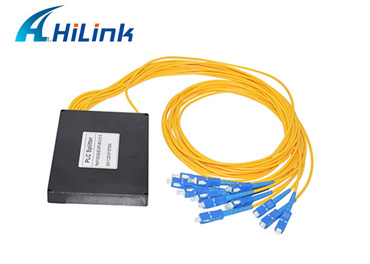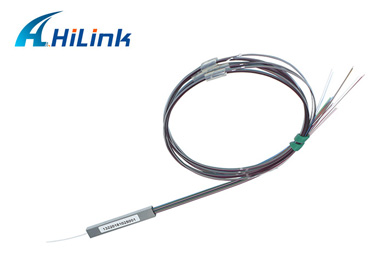FBT Splitter vs PLC Splitter: What Are the Differences?
Feb. 06, 2023
A fiber optic splitter is a passive optical device that splits or separates an incident beam into two or more beams. Basically, fiber optic splitters are divided into two types according to their operating principle: FBT splitters (fused biconical taper splitters) and PLC splitters (planar optical wave path splitters). There are many differences between FBT splitters and PLC splitters, which confuse many users. This tutorial will guide you through the main elements between them.
What Is PLC Splitter?
PLC splitter is based on planar lightwave circuit technology. It comprises three layers: a substrate, a waveguide, and a lid. The waveguide plays a key role in the splitting process which allows for passing specific percentages of light. So the signal can be split equally. In addition, PLC splitters are available in a variety of split ratios, including 1:4, 1:8, 1:16, 1:32, 1:64, etc. They also have several types, such as bare PLC splitter, blockless PLC splitter, fanout PLC splitter, mini plug-in type PLC splitter, etc.
Hilink Planar Lightwave Circuits (PLC) Optical Splitters are fully passive optical branching devices that exhibit very low insertion loss and PDL, great channel uniformity, and a wide wavelength operative range. These PLC optical splitters are manufactured and tested to Telcordia-1209-core & GR-1221-core which provide high performance, specifically designed to meet the tough requirement of FTTH, PON, and CATV networks.
PLC Splitter
What Is FBT Splitter?
FBT splitter is based on traditional technology to weld several fibers together from the side of the fiber. Fibers are aligned by heating for a specific location and length. Because the fused fibers are very fragile, they are protected by a glass tube made of epoxy and silica powder. And then a stainless steel tube covers the inner glass tube and is sealed by silicon. As technology continues developing, the quality of the FBT splitter is very good and it can be applied in a cost-effective way.
FBT Splitter vs PLC Splitter: What Are the Differences?
1. Operating Wavelength
FBT splitter only supports three wavelengths: 850nm, 1310nm, and 1550nm, which makes it inability to work on other wavelengths. The PLC splitter can support wavelengths from 1260 to 1650nm. The adjustable range of wavelength makes the optical plc splitter suitable for more applications.
2. Splitting Ratio
The splitting ratio is decided by the inputs and outputs of an optical cable splitter. The maximum split ratio of the FBT splitter is up to 1:32, which means one or two inputs can be split into an output maximum of 32 fibers at a time. However, the split ratio of the PLC splitter is up to 1:64 - one or two inputs with an output maximum of 64 fibers.
Optical PLC Splitter
3. Asymmetric Attenuation Per Branch
The signal processed by FBT splitters cannot be split evenly due to a lack of management of the signals, so its transmission distance can be affected. However, a PLC splitter can support equal splitter ratios for all branches, which can ensure a more stable optical transmission.
4. Failure Rate
FBT splitter is typically used for networks requiring the splitter configuration of fewer than 4 splits. The larger the split, the greater the failure rate. When its splitting ratio is larger than 1:8, more errors will occur and cause a higher failure rate. Thus, the FBT splitter is more restricted to the number of splits in one coupling. But the failure rate of PLC splitter is much smaller.
5. Temperature-Dependent Loss
In certain areas, the temperature can be a crucial factor that affects the insertion loss of optical components. FBT splitter can work stable under the temperature of -5 to 75℃. PLC splitter can work at a wider temperature range of -40 to 85 ℃, providing relatively good performance in the areas of extreme climate.
Conclusion
Although the outer appearance and size of FBT and PLC fiber splitters seem rather similar, their internal technologies and specifications differ in various ways. Over the past few years, splitter technology has made a huge step forward in the past few years by introducing the PLC splitter. It has proven itself as a higher reliable type of device compared to the traditional FBT splitter. If high split counts, small package size, and low insertion loss are required, you are suggested to choose a PLC splitter rather than an FBT splitter.














